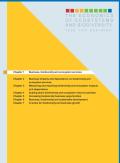Questions about the ultimate size of mineral and energy resource endowments and the degree of fiscal prudence which should be exercised by countries engaged in resource extraction have become central for many developing countries during the recent resource boom. To explore these questions, this paper develops a model of optimal resource extraction and discovery that combines two polar assumptions: (i) that discovering a resource today drives up the cost of future resource discoveries, and (ii) that extracting resources yields knowledge that reduces the cost of discovery.
Although the model shows that resource discoveries should be valued at marginal discovery cost in measures of national saving and income, the ultimate size of the resource that can be exploited is the result of the interplay between rising discovery costs and accumulating knowledge. Empirical tests of the model show that the resulting income estimates would be extremely volatile for many extractive economies, owing to the lumpiness of resource discoveries. Two alternative accounting approaches, based on Hicksian concepts, yield more intuitive and less volatile income estimates.
The private sector is increasingly seeing the opportunities that come along with ‘green growth’ as well as the relevance of mitigating environmental and social risks to which they are exposed.
This paper’s central message is that high quality information is necessary to support decisions that drive green growth. Accordingly, the paper aims to:
- survey the landscape of corporate reporting relevant to green growth, including the key user groups, the business rationale for reporting and examples of corporate reporting;
- discuss the existing guidance that supports business in corporate reporting relevant to green growth;
- identify the key barriers to corporate reporting relevant to green growth; and
- identify research gaps.

The goal of The Economics of Ecosystems and Biodiversity (TEEB) Ecological and Economic Foundations is to provide the conceptual foundation to link economics and ecology, to highlight the relationship between biodiversity and ecosystem services and to show their importance for human well-being. This volume of the overal TEEB series tackles the challenges of valuing ecosystem services, as well as issues related to economic discounting. It aims to quantify the costs of inaction and examine the macroeconomic dimension of ecosystem services loss. This information will focus on improving our understanding of the economic costs of biodiversity loss and ecosystem degradation.
Examples include water and air quality regulation, nutrient cycling and decomposition, plant pollination and flood control, all of which are dependent on biodiversity. They are predominantly public goods with limited or no markets and do not command any price in the conventional economic system, so their loss is often not detected and continues unaddressed and unabated. This in turn not only impacts human well-being, but also seriously undermines the sustainability of the economic system.

This paper examines the processes used in the United States and Mexico to assess the economic costs and benefits of environmental improvement, the kinds of information obtained from these procedures, and the additional knowledge that is needed about both elements to improve understanding of the problems and prospects of advancing a green growth agenda. Because environmental and other development needs are large and resources are limited, it is important to choose the best projects, those with the highest returns on both public investments and private resources harnessed by regulation. The United States is a well-recognized leader in the use of quantitative methods to evaluate options for environmental regulation and policy. Mexico represents a case where a country has made clear advances in reforming its economy and in introducing transparency in its regulatory processes for environmental and other policy areas.
